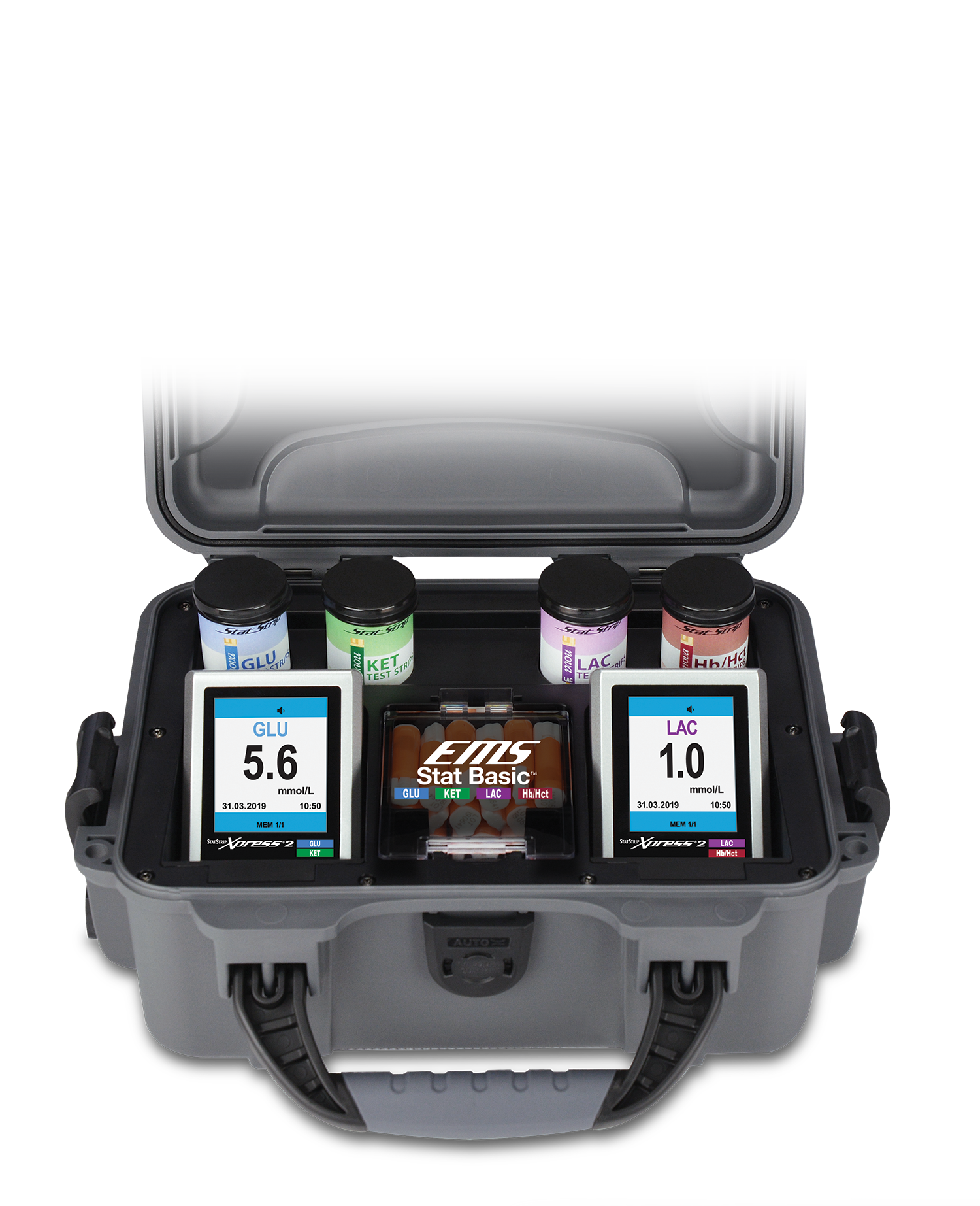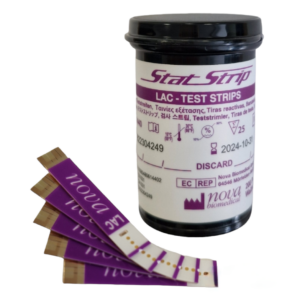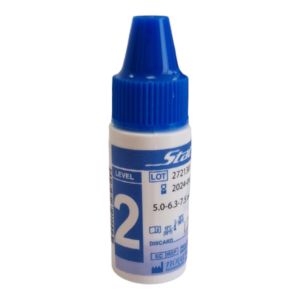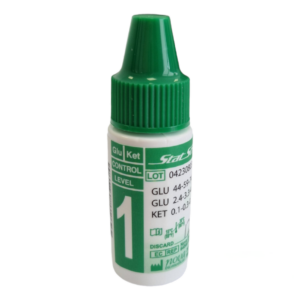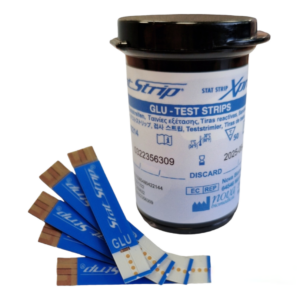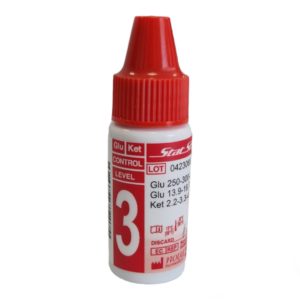StatStrip Xpress 2 LAC/Hb/Hct Meter & StatStrip XPRESS 2 GLUCOSE/KETONE METER
£2,040.00 inc VAT (£1,700.00 + VAT)
StatStrip Xpress 2 LAC/Hb/Hct Meter
The Nova StatStrip Xpress Glucose Hospital Meter System is the first FDA clearance of a device specifically indicated for use in all types of hospital patients, including critically ill patients.
Fingerstick Capillary Blood Testing for Lactate, Hb, and Hct
The StatStrip Xpress Lactate and Haemoglobin/Haematocrit Meter system (StatStrip LAC/Hb/Hct) is a handheld, easy-to-use meter system that measures LAC, Hb and Hct at the point-of-care using two disposable biosensors and tiny capillary blood samples for all tests. StatStrip Xpress’ Lactate biosensor provides lab-like accuracy in just 13 seconds from 0.6 microliters of capillary blood. StatStrip Xpress’ Hb/Hct biosensor accurately measures – not calculates – both Hb and Hct in 40 seconds from a 1.6 microliter capillary sample.
StatStrip Xpress 2 Glucose/Ketone Meter
StatStrip Xpress 2 is the world’s most extensively studied and proven glucose test.
*Test Strips and Lancets sold separately
StatStrip Xpress 2 LAC/Hb/Hct Meter (Lactate, Hemoglobin, and Hematocrit)
Lactate Testing Bedside
StatStrip LAC/Hb/Hct is a point-of-care (POC) system that enables rapid and timely trending of lactate in hypoperfusion during sepsis (or other conditions of hypoperfusion) for assessment of resuscitation or treatment efforts. Compared to testing with blood gas analyzers which require arterial samples, large samples volumes (up to 95 microliters), and long analysis times (up to 2.5 minutes); StatStrip’s single-use biosensor provides the fastest turnaround time (13 seconds) on the smallest whole blood sample (0.6 μL) with excellent correlation to central laboratory reference methods.
Solves Lactate Pre-Analytical issues
Lactate is not stable in whole blood samples. Blood lactate levels rise steeply in less than 5 minutes if samples are transported or kept at room temperature.1 StatStrip point-of- care testing ensures rapid, accurate results by eliminating sample transport preanalytical effects.
Hemoglobin and Hematocrit Testing Bedside
StatStrip Xpress LAC/Hb/Hct is the only POC system to provide anaemia screening and monitoring with measured, not calculated, Hb and Hct tests. This important breakthrough is possible because of new, patented biosensor technologies developed by Nova Biomedical.
Accurate Assessment of Anemia
Accurate anaemia evaluation requires both measured Hct and measured Hb. However, current POC Hb meters only provide a calculated estimate of Hct. Calculated estimates of Hct are inaccurate in many conditions including red cell structural abnormalities, hemolysis, hemoglobinopathies, and other conditions. These conditions necessitate measured Hct because calculated results can negatively impact treatment.
Smallest and Lightest Meters
StatStrip Xpress LAC/Hb/Hct meters are smaller and lighter than other POC devices that measure lactate or hemoglobin only. StatStrip lightweight, small meters enable testing at the bedside or patient-side.
Weight: 78.5 g (2.77 oz )
Size: 8.0 mm x 61.0 mm x 22.9 mm (3.9inx2.4inx0.9in)
Data Storage:
Patient & QC Tests: 400 tests total (FIFO)
Battery Information:
Type: 2 AAA batteries Features:
Replaceable Life: Minimum 600 tests
Operating Ranges:
Temperature: 1 ̊C-40 ̊C (34 ̊F-104 ̊F)
Altitude: Up to 4,572 m (15,000 ft)
Humidity: 10%-90% relative humidity
Additional Features:
• LCD color display
• Large numeric display (30 mm)
• Traditional QC with target values assigned to QC materials
• Units of measure based on meter ordered (mg/dL or mmol/L models)
• Automatic shut-off when not in use
• Automatic sample detection and analysis
• Automatic sample counting with date/time stamp for data tracking
StatStrip Xpress 2 Glucose/Ketone Meter
The StatStrip Xpress Glucose/Ketone Hospital Meter System offers bidirectional wireless connectivity to hospital HIS or LIS with complete security to protect patient data.
- Wireless connectivity can transmit patient results directly from the bedside, alleviating the need to bring the meter to a fixed location for meter docking and data transmission.
- Wireless connectivity saves time for the caregiver and allows for faster charting of results and clinical decision making to improve patient care.
- Dual-band wireless connectivity provides complete security and encryption to ensure that patient data remains uncompromised.
Measures ketones with same meter
Easy to use
No meter preparation or calibration coding steps are required. Insert a ketone strip and StatStrip Glucose/Ketone meter automatically recognizes the strip and converts the meter to ketone measuring mode.
Blood ketone testing should be performed whenever glucose exceeds 14 mmol/L (250 mg/dL)
Diabetes UK, the Canadian Diabetes Association, the European Society for Paediatric Endocrinology, and the American Diabetes Association (ADA) recommend that blood ketone testing be performed whenever glucose exceeds 14 to 17 mmol/L for rapid detection or prevention of diabetic ketoacidosis (DKA).
StatStrip Glucose/Ketone measures blood beta-hydroxybutyrate, the preferred ketone for diagnosing ketoacidosis
According to the European Society for Paediatric Endocrinology, Diabetes UK, ADA, and others, blood ketone testing methods that quantify beta-hydroxybutyrate, the predominant ketone body in DKA, are recommended over urine ketone testing for diagnosing and monitoring ketoacidosis.
Ketone testing results obtained from capillary samples
Capillary blood samples are not only preferred over urine samples to detect and monitor DKA,
they are also easier to obtain and allow for immediate reflex testing of ketones whenever glucose is greater than 14 mmol/L.
Blood ketone monitoring reduces costs and ICU length of stay for DKA patients
An ICU study evaluated the effectiveness of blood ketone testing versus urine ketone testing for DKA patients. The blood ketone testing group of patients left the ICU 6.5 hours earlier than the urine ketone testing group. This led to savings of 22 hours of nursing time and 375 laboratory investigations, for a total savings of €2,940.1
A second study of DKA patients compared a DKA therapy endpoint of pH > 7.3 and blood ketones < 1.0 mmol/L, versus an endpoint of pH > 7.3 and negative urine ketones. The pH/ blood ketone endpoint was reached after 17 hours, whereas the pH/urine ketone endpoint was not reached until 28 hours after starting treatment. The mean lag between the blood ketone and urine ketone groups was 11 hours, ranging from 1 to 36 hours.2
Blood ketone is more accurate than urine ketone testing
Blood beta-hydroxyburyrate testing indicates the patient’s status at the time of the test, whereas urine may have been in the bladder for several hours. Urine testing can also produce false positive or negative results due to highly colored urine, highly acidic urine, exposure of the urine test strips to air for prolonged periods, drugs such as the ACE inhibitor captopril, or high doses of vitamin C.
Designed for applications that do not need data interfacing and connectivity, Xpress2 retains all of the analytical performance features of StatStrip Glucose.
Weight: 2.77 oz (78 g)
Size: 3.9 in x 2.4 in x 0.9 in
(98 mm x 61 mm x 22.9 mm)
Data Storage:
Patient & QC Tests: 400 tests total (FIFO)
Connectivity:
Data Transfer: Strip Port Connection to USB
Data Program: Nova Microsoft-Excel based data transfer software
Battery Information:
Type: 3V Li Button Battery
Features: Replaceable
Life: Minimum 600 tests
Additional Features:
- LCD color display
- Large numeric display (30 mm)
- Traditional QC with target values assigned to QC materials
- Units of measure based on meter ordered (mg/dl or mmol/L models)
- Automatic shut-off when not in use
- Automatic sample detection and analysis start
- Automatic sample counter with date/time stamp for data tracking
Do you have any questions about StatStrip Xpress 2 LAC/Hb/Hct Meter & StatStrip XPRESS 2 GLUCOSE/KETONE METER?
You may also like…
-
StatStrip Lactate Test Strips (Box of 50)
£177.00 inc VAT (£147.50 + VAT) View Product -
StatStrip Xpress Lactate Control Solution – Level 2
£18.00 inc VAT (£15.00 + VAT) View Product -
StatStrip Xpress Glucose and Ketone Control Solution – Level 1
£18.00 inc VAT (£15.00 + VAT) View Product -
StatStrip Xpress Glucose Test Strips (Box of 100)
£51.42 inc VAT (£42.85 + VAT) View Product -
StatStrip Xpress Glucose and Ketone Control Solution – Level 3
£18.00 inc VAT (£15.00 + VAT) View Product
